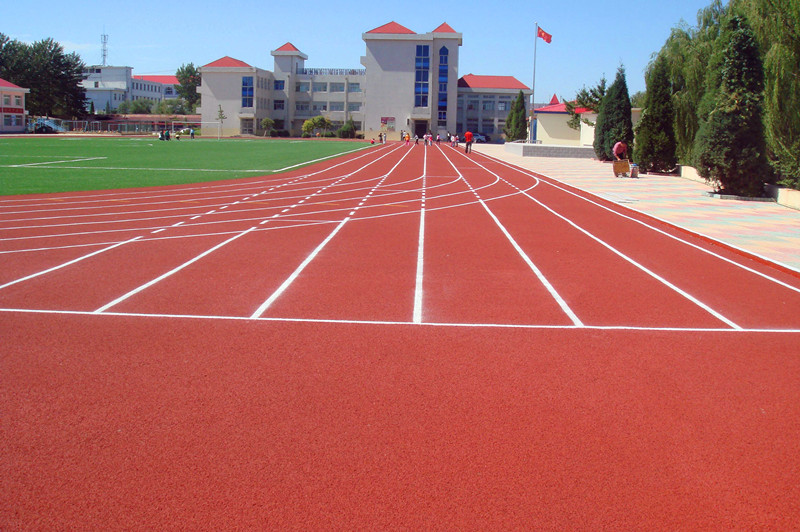Recently, students have been exposed by the media due to numerous news events on plastic track poisoning in schools. The plastic plastic track has officially entered the public attention and became the heart of the parents. For this reason, the society has also called for: Please return your child to health. Playground. Is the poisonous plastic track really terrible?

Chinese school playgrounds are currently based on plastic materials.
Where is the poisonous plastic track in the end?
At present, the domestic plastic track is generally made of polyurethane material, supplemented by pigments and additives. A quality-qualified polyurethane generally does not volatilize harmful substances.
Polyurethane is a chain molecule polymerized by two monomers, "polyether polyol" and "diisocyanate". Just like an iron chain connected by a small iron ring,
Polyurethane is equivalent to a long iron chain, which is equivalent to a separate iron ring. If the two monomers are completely polymerized, the polyurethane itself is not harmful.
The key is that there are more than two monomers that are not polymerized in the inferior polyurethane, and one of the sources harmful to the human body is the two monomers.
Polyether polyols are not harmful in their own right, but there are some impurities in the process of their formation. For example, aldehydes such as formaldehyde, which are well known, are volatilized and adhered to stimulate our respiratory tract and skin. Feeling of discomfort.
Diisocyanate can be said to be a highly toxic substance, which has a strong pungent odor and has a strong stimulating effect on the skin, eyes and respiratory tract.
When it is inhaled, it can cause bronchitis, bronchial pneumonia and pulmonary edema. When it comes into contact with the skin, it can cause dermatitis. Contact with the eyes can cause severe irritation. If left untreated, it may cause permanent damage.
In particular, people who are allergic to diisocyanate may experience symptoms such as wheezing, difficulty breathing, and coughing after exposure. In severe cases, it can cause redness and chemical burns, and can damage the nasal mucosa, upper respiratory tract mucosa, and even cause chemical damage.
Studies have shown that diisocyanates are harmful to the body's hematopoietic function, and some of the diisocyanate practitioners' platelets are reduced. In severe cases, it usually suffers from leukemia.
How to detect and reduce poison?
Whether the plastic track is qualified or not, the conventional testing methods generally include: test method for resistance to sunlight exposure of vulcanized rubber under glass, determination of component content of rubber and rubber products, and thermogravimetric analysis.
One method of laboratory testing is to cut the plastic track into pieces, soak it in water, and then feed the rats to see the rat's response to determine the quality of the runway.
For the average public, the easiest and most helpless way is to smell by the nose. If there is an odor, it is likely to be caused by the volatilization of harmful residues in the plastic track.
To reduce the hazards of plastic runways, it is necessary to start with two main toxic substances: reduce toxic impurities such as aldehydes in polyether polyols, so that the toxic substances in the finally prepared polyurethane will also be reduced. Reduce the risk of diisocyanate. This can be done from two aspects. On the one hand, it is as polymerized as possible in the preparation of the polyurethane, so that the residual of the diisocyanate is reduced as much as possible. On the other hand, in the preparation of polyurethane, diphenylmethane diisocyanate (MDI) is used.
Is the standard for plastic runway nationals really accurate?
According to reports, the current national standards related to plastic track products in China are "Sports Field Requirements and Test Methods Part 6: Track and Field Sites" and "Synthetic Material Runway Surface Layer". However, the existence of standard easing in both "national standards" has led manufacturers to use organic solvents and even toxic solvents in large quantities, and both are non-mandatory standards, resulting in "standard without implementation" defects. It can be said that this is also the case that the plastic runway is almost "streaking" in the past ten years. This situation is undoubtedly heavy.
A national standard for plastic runways seems to be imperative. But besides that, we would like to draw more attention to whether the plastic track should be the standard for every school.
Is the plastic runway really irreplaceable?
On July 1, 1979, China's first plastic track was laid at the Beijing Workers' Stadium. The country that cooperated with China to construct this runway was Japan. Nowadays, the sleek plastic track has blossomed all over the campuses in China, but in Japan, the primary and secondary schools generally use a sandy playground with a relatively low “face valueâ€.
It is understood that the playgrounds in Japan generally use sand running tracks, and even plant some vegetation on them, which looks quite primitive, and the plastic track is rare in Japan. Under the premise that the plastic track is not up to standard, should we also consider returning to the truth? After all, health is the first, isn't it?
Digital Motor,Dolat Tubular Motor,Tubular Motor Controller,White Step Tubular Motor
Zhejiang Huzhou SCVE Machine & Motor Co., Ltd. , https://www.scve-motor.com